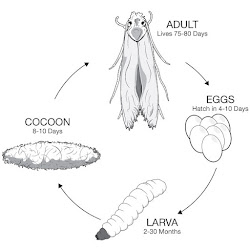 |
| Tineola bisselliella |
It is unlikely you will see the adult clothes moths because they avoid bright wide-open spaces. But, if you see a small (about ½”) moth with a fringe of golden hairs along their wings and on top of their heads, that’s an adult clothes moth. Another identifier is that they are poor flyers and basically flutter around ineffectually, as opposed to the purposeful, direct flying of other moth species.
It’s important to understand that killing any adult moths you may see will not fix your problem, as it is their larval stage that does the damage. Females lay between 40 and 50 eggs during their life span. Once a female has eggs, she secretes an adhesive substance that she uses to attach her eggs to fabrics. In warm weather, these eggs can hatch in 4-10 days and in the warm interior of homes this process can go on year-round. Once the eggs hatch, they dig into the fabrics they were placed on and use them for food and shelter. |
| Moths with larvae |
 • It may seem indelicate to say, but good housekeeping and only storing clean garments helps immensely. Clothes moths are drawn to materials that are holding body oils and food residue. They will also find areas in the home that don’t often get deep-cleaned, like under furniture.
• It may seem indelicate to say, but good housekeeping and only storing clean garments helps immensely. Clothes moths are drawn to materials that are holding body oils and food residue. They will also find areas in the home that don’t often get deep-cleaned, like under furniture.
 |
• Whenever possible, store clothing by hanging it instead of folding it. The larvae are drawn to folds they can hide in. If you store items in a hanging garment bag, be sure to thoroughly tape up the zipper and closure area.
• Rotate items in a closet regularly so that nothing stays hidden in the dark too long.
• Periodically air out and allow light into your closet or storage area – clothes moths will abandon an area if they cannot find a spot safe from bright light.A few words about cedar: For hundreds of years people stored their garments in cedar chests and cedar-lined closets in the belief that cedar keeps the moths away. We now know that the efficacy of cedar as a deterrent/repellent wans as soon as the oils dry. However, if you use a cedar chest and it closes tightly it will act as a barrier control long after the oils are gone.
Mothballs are another traditional method of control that is still recommended with some caveats. These aromatic spheres are strong pesticides that work best in ample numbers in closed environments, which means that the fumes can build up and make you sick. Additionally, the chemicals in moth balls can soften plastic, which may allow moths to enter.Cleaning up an infestation includes many of the steps delineated above, with a few additional deep-cleaning steps and pesticidal options. Adding sticky traps to the area when possible is also effective, as are pheromone lures/traps. These types of traps eliminate the love-hungry males and cut down on future generations. Here are some additional guidelines from the famous home guru, Bob Vila. Although labor-intensive, prevention and elimination of clothes moths is possible.Take Care
Submitted by Pam










No comments:
Post a Comment